Homeostasis, Coordination & Control
VerifiedAdded on 2020/12/26
|8
|1610
|452
Homework Assignment
AI Summary
This assignment provides detailed answers to questions related to homeostasis, coordination and control, and the excretory system. It covers topics like blood glucose regulation, nerve impulse transmission, hormone action, and the role of liver and kidney in excretion. The assignment also includes a breakdown of the nephron structure and its functions.
Contribute Materials
Your contribution can guide someone’s learning journey. Share your
documents today.
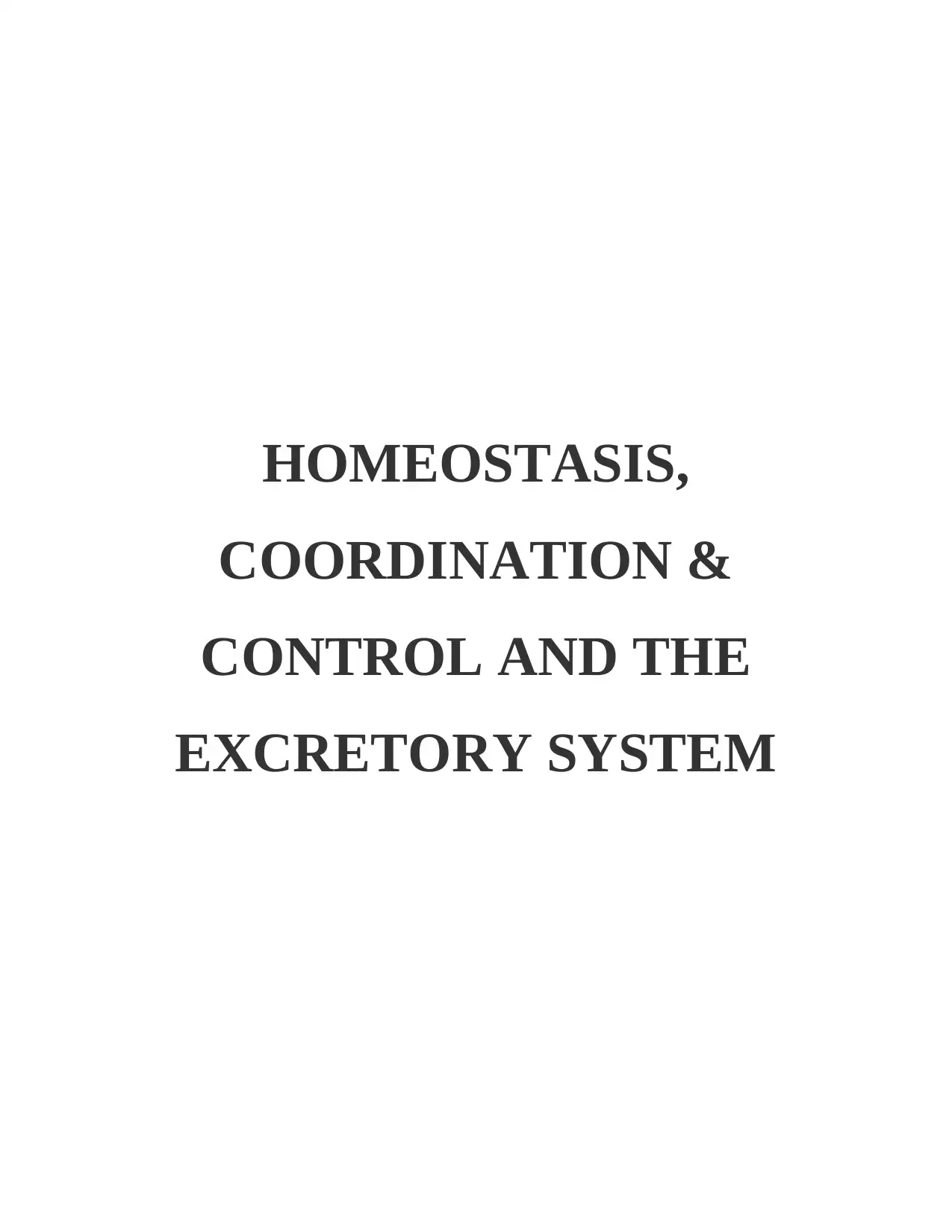
HOMEOSTASIS,
COORDINATION &
CONTROL AND THE
EXCRETORY SYSTEM
COORDINATION &
CONTROL AND THE
EXCRETORY SYSTEM
Secure Best Marks with AI Grader
Need help grading? Try our AI Grader for instant feedback on your assignments.
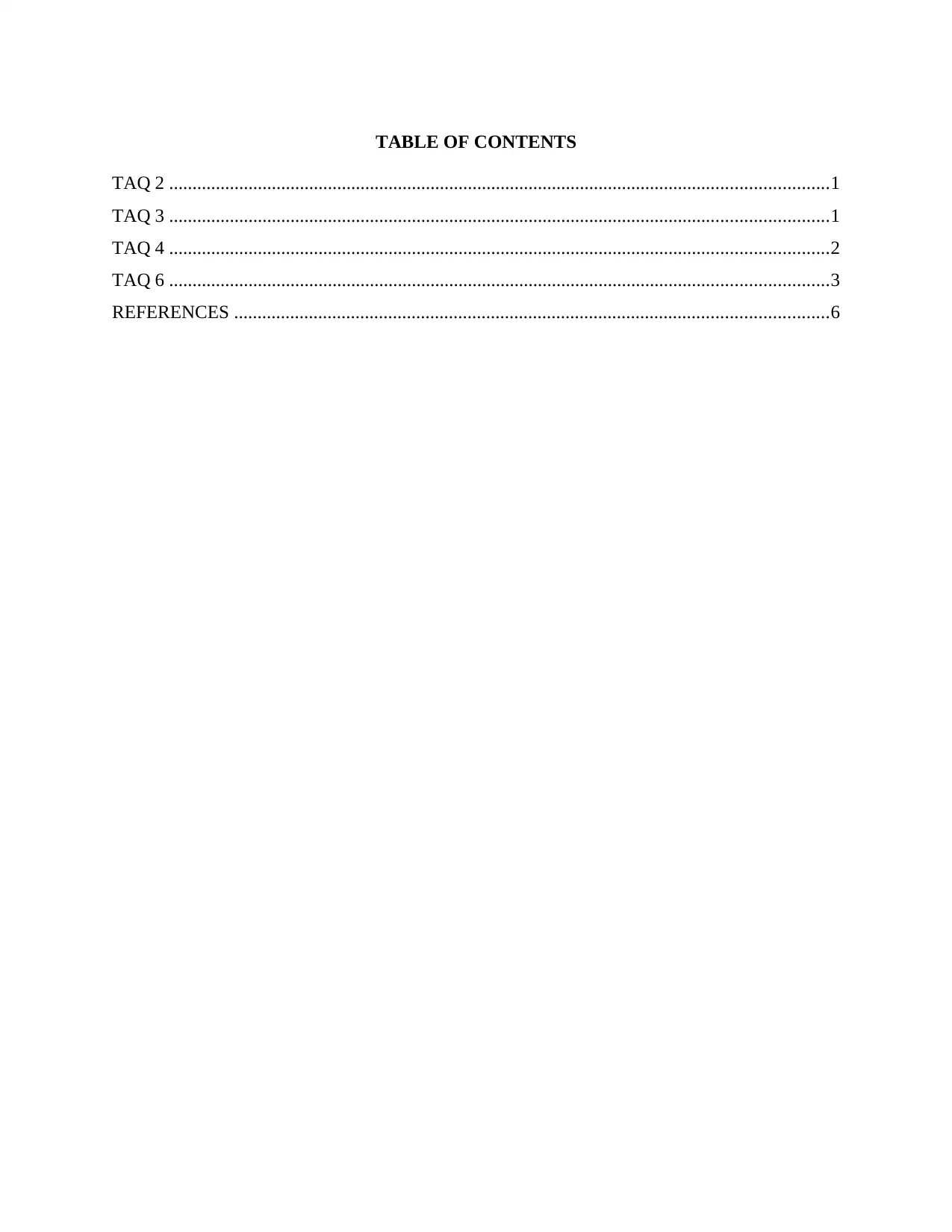
TABLE OF CONTENTS
TAQ 2 .............................................................................................................................................1
TAQ 3 .............................................................................................................................................1
TAQ 4 .............................................................................................................................................2
TAQ 6 .............................................................................................................................................3
REFERENCES ...............................................................................................................................6
TAQ 2 .............................................................................................................................................1
TAQ 3 .............................................................................................................................................1
TAQ 4 .............................................................................................................................................2
TAQ 6 .............................................................................................................................................3
REFERENCES ...............................................................................................................................6
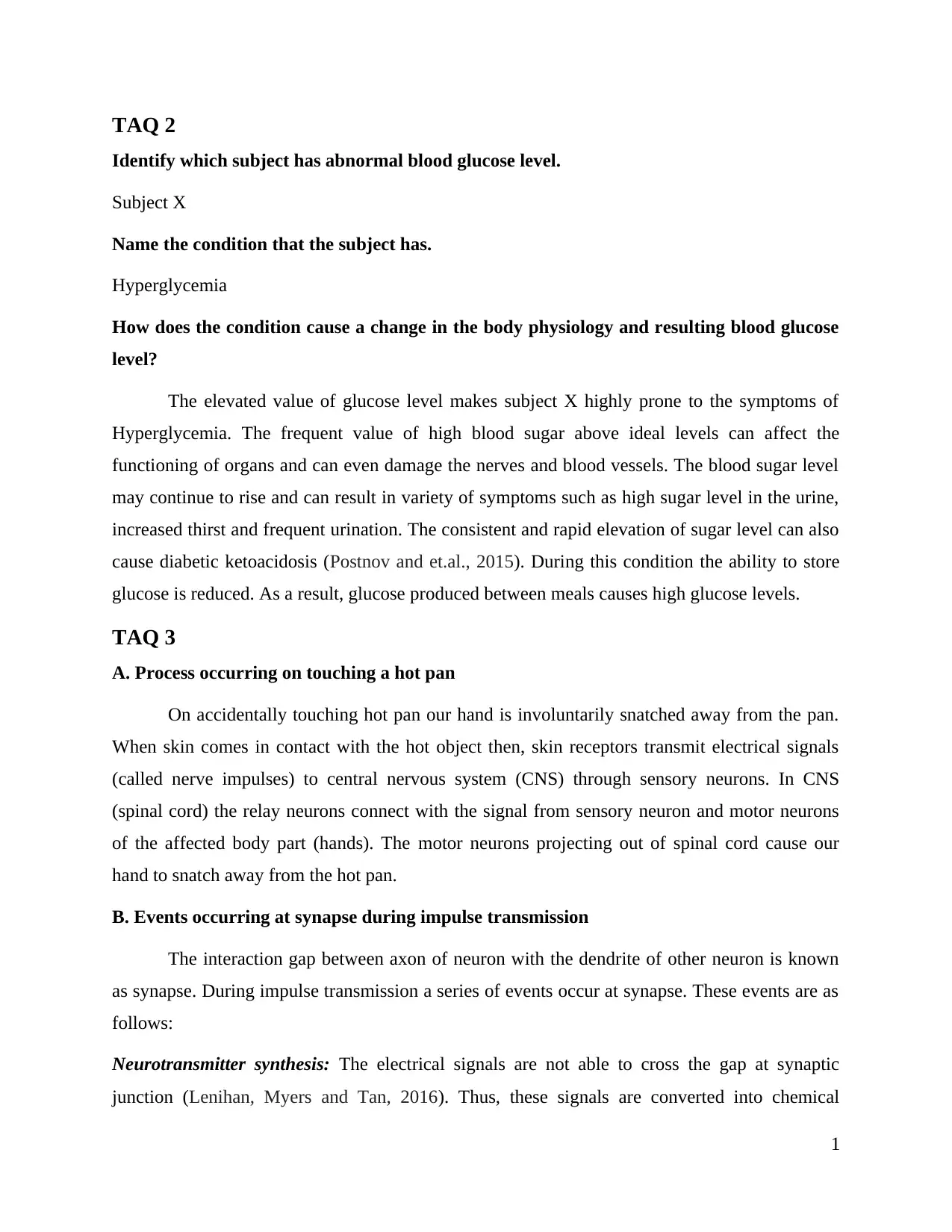
TAQ 2
Identify which subject has abnormal blood glucose level.
Subject X
Name the condition that the subject has.
Hyperglycemia
How does the condition cause a change in the body physiology and resulting blood glucose
level?
The elevated value of glucose level makes subject X highly prone to the symptoms of
Hyperglycemia. The frequent value of high blood sugar above ideal levels can affect the
functioning of organs and can even damage the nerves and blood vessels. The blood sugar level
may continue to rise and can result in variety of symptoms such as high sugar level in the urine,
increased thirst and frequent urination. The consistent and rapid elevation of sugar level can also
cause diabetic ketoacidosis (Postnov and et.al., 2015). During this condition the ability to store
glucose is reduced. As a result, glucose produced between meals causes high glucose levels.
TAQ 3
A. Process occurring on touching a hot pan
On accidentally touching hot pan our hand is involuntarily snatched away from the pan.
When skin comes in contact with the hot object then, skin receptors transmit electrical signals
(called nerve impulses) to central nervous system (CNS) through sensory neurons. In CNS
(spinal cord) the relay neurons connect with the signal from sensory neuron and motor neurons
of the affected body part (hands). The motor neurons projecting out of spinal cord cause our
hand to snatch away from the hot pan.
B. Events occurring at synapse during impulse transmission
The interaction gap between axon of neuron with the dendrite of other neuron is known
as synapse. During impulse transmission a series of events occur at synapse. These events are as
follows:
Neurotransmitter synthesis: The electrical signals are not able to cross the gap at synaptic
junction (Lenihan, Myers and Tan, 2016). Thus, these signals are converted into chemical
1
Identify which subject has abnormal blood glucose level.
Subject X
Name the condition that the subject has.
Hyperglycemia
How does the condition cause a change in the body physiology and resulting blood glucose
level?
The elevated value of glucose level makes subject X highly prone to the symptoms of
Hyperglycemia. The frequent value of high blood sugar above ideal levels can affect the
functioning of organs and can even damage the nerves and blood vessels. The blood sugar level
may continue to rise and can result in variety of symptoms such as high sugar level in the urine,
increased thirst and frequent urination. The consistent and rapid elevation of sugar level can also
cause diabetic ketoacidosis (Postnov and et.al., 2015). During this condition the ability to store
glucose is reduced. As a result, glucose produced between meals causes high glucose levels.
TAQ 3
A. Process occurring on touching a hot pan
On accidentally touching hot pan our hand is involuntarily snatched away from the pan.
When skin comes in contact with the hot object then, skin receptors transmit electrical signals
(called nerve impulses) to central nervous system (CNS) through sensory neurons. In CNS
(spinal cord) the relay neurons connect with the signal from sensory neuron and motor neurons
of the affected body part (hands). The motor neurons projecting out of spinal cord cause our
hand to snatch away from the hot pan.
B. Events occurring at synapse during impulse transmission
The interaction gap between axon of neuron with the dendrite of other neuron is known
as synapse. During impulse transmission a series of events occur at synapse. These events are as
follows:
Neurotransmitter synthesis: The electrical signals are not able to cross the gap at synaptic
junction (Lenihan, Myers and Tan, 2016). Thus, these signals are converted into chemical
1
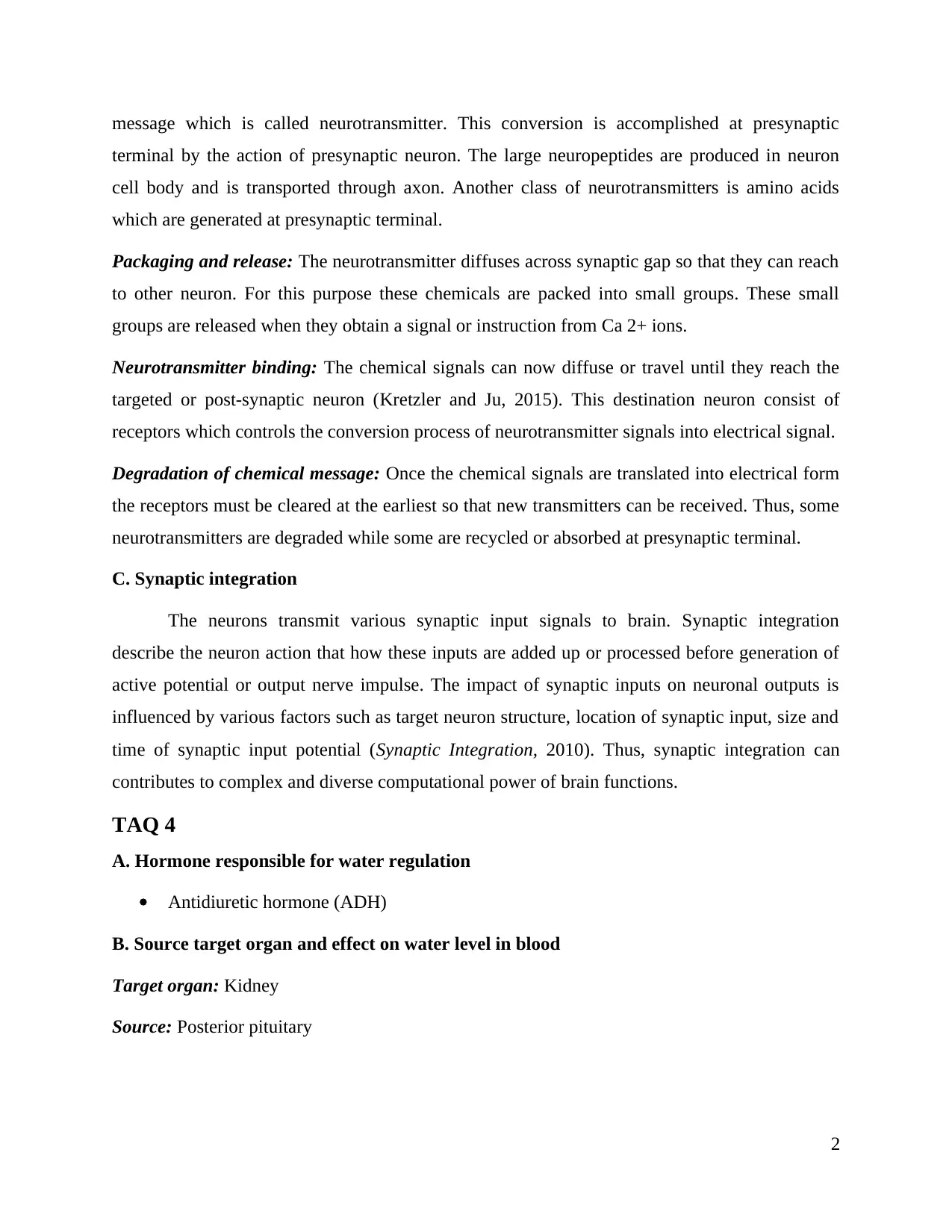
message which is called neurotransmitter. This conversion is accomplished at presynaptic
terminal by the action of presynaptic neuron. The large neuropeptides are produced in neuron
cell body and is transported through axon. Another class of neurotransmitters is amino acids
which are generated at presynaptic terminal.
Packaging and release: The neurotransmitter diffuses across synaptic gap so that they can reach
to other neuron. For this purpose these chemicals are packed into small groups. These small
groups are released when they obtain a signal or instruction from Ca 2+ ions.
Neurotransmitter binding: The chemical signals can now diffuse or travel until they reach the
targeted or post-synaptic neuron (Kretzler and Ju, 2015). This destination neuron consist of
receptors which controls the conversion process of neurotransmitter signals into electrical signal.
Degradation of chemical message: Once the chemical signals are translated into electrical form
the receptors must be cleared at the earliest so that new transmitters can be received. Thus, some
neurotransmitters are degraded while some are recycled or absorbed at presynaptic terminal.
C. Synaptic integration
The neurons transmit various synaptic input signals to brain. Synaptic integration
describe the neuron action that how these inputs are added up or processed before generation of
active potential or output nerve impulse. The impact of synaptic inputs on neuronal outputs is
influenced by various factors such as target neuron structure, location of synaptic input, size and
time of synaptic input potential (Synaptic Integration, 2010). Thus, synaptic integration can
contributes to complex and diverse computational power of brain functions.
TAQ 4
A. Hormone responsible for water regulation
Antidiuretic hormone (ADH)
B. Source target organ and effect on water level in blood
Target organ: Kidney
Source: Posterior pituitary
2
terminal by the action of presynaptic neuron. The large neuropeptides are produced in neuron
cell body and is transported through axon. Another class of neurotransmitters is amino acids
which are generated at presynaptic terminal.
Packaging and release: The neurotransmitter diffuses across synaptic gap so that they can reach
to other neuron. For this purpose these chemicals are packed into small groups. These small
groups are released when they obtain a signal or instruction from Ca 2+ ions.
Neurotransmitter binding: The chemical signals can now diffuse or travel until they reach the
targeted or post-synaptic neuron (Kretzler and Ju, 2015). This destination neuron consist of
receptors which controls the conversion process of neurotransmitter signals into electrical signal.
Degradation of chemical message: Once the chemical signals are translated into electrical form
the receptors must be cleared at the earliest so that new transmitters can be received. Thus, some
neurotransmitters are degraded while some are recycled or absorbed at presynaptic terminal.
C. Synaptic integration
The neurons transmit various synaptic input signals to brain. Synaptic integration
describe the neuron action that how these inputs are added up or processed before generation of
active potential or output nerve impulse. The impact of synaptic inputs on neuronal outputs is
influenced by various factors such as target neuron structure, location of synaptic input, size and
time of synaptic input potential (Synaptic Integration, 2010). Thus, synaptic integration can
contributes to complex and diverse computational power of brain functions.
TAQ 4
A. Hormone responsible for water regulation
Antidiuretic hormone (ADH)
B. Source target organ and effect on water level in blood
Target organ: Kidney
Source: Posterior pituitary
2
Secure Best Marks with AI Grader
Need help grading? Try our AI Grader for instant feedback on your assignments.
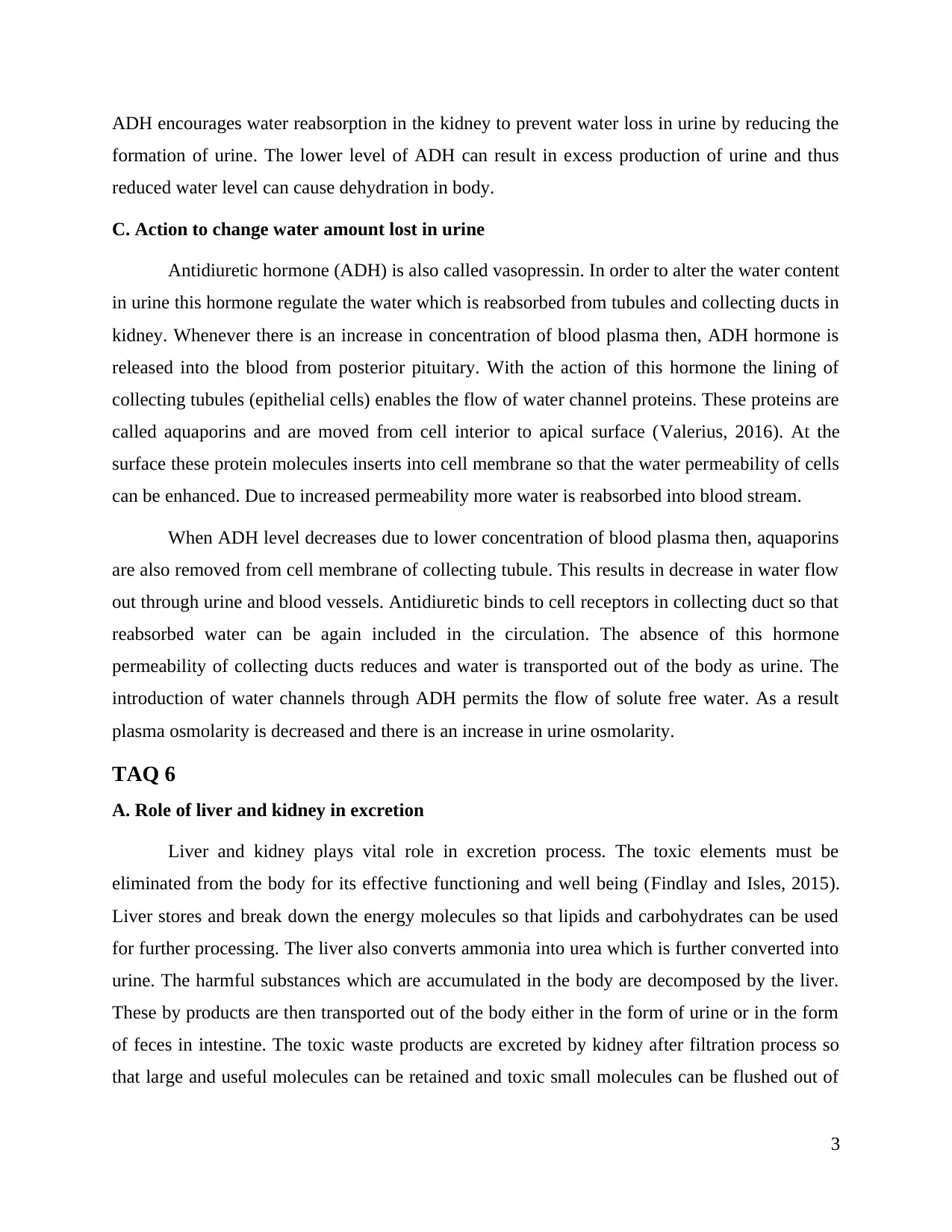
ADH encourages water reabsorption in the kidney to prevent water loss in urine by reducing the
formation of urine. The lower level of ADH can result in excess production of urine and thus
reduced water level can cause dehydration in body.
C. Action to change water amount lost in urine
Antidiuretic hormone (ADH) is also called vasopressin. In order to alter the water content
in urine this hormone regulate the water which is reabsorbed from tubules and collecting ducts in
kidney. Whenever there is an increase in concentration of blood plasma then, ADH hormone is
released into the blood from posterior pituitary. With the action of this hormone the lining of
collecting tubules (epithelial cells) enables the flow of water channel proteins. These proteins are
called aquaporins and are moved from cell interior to apical surface (Valerius, 2016). At the
surface these protein molecules inserts into cell membrane so that the water permeability of cells
can be enhanced. Due to increased permeability more water is reabsorbed into blood stream.
When ADH level decreases due to lower concentration of blood plasma then, aquaporins
are also removed from cell membrane of collecting tubule. This results in decrease in water flow
out through urine and blood vessels. Antidiuretic binds to cell receptors in collecting duct so that
reabsorbed water can be again included in the circulation. The absence of this hormone
permeability of collecting ducts reduces and water is transported out of the body as urine. The
introduction of water channels through ADH permits the flow of solute free water. As a result
plasma osmolarity is decreased and there is an increase in urine osmolarity.
TAQ 6
A. Role of liver and kidney in excretion
Liver and kidney plays vital role in excretion process. The toxic elements must be
eliminated from the body for its effective functioning and well being (Findlay and Isles, 2015).
Liver stores and break down the energy molecules so that lipids and carbohydrates can be used
for further processing. The liver also converts ammonia into urea which is further converted into
urine. The harmful substances which are accumulated in the body are decomposed by the liver.
These by products are then transported out of the body either in the form of urine or in the form
of feces in intestine. The toxic waste products are excreted by kidney after filtration process so
that large and useful molecules can be retained and toxic small molecules can be flushed out of
3
formation of urine. The lower level of ADH can result in excess production of urine and thus
reduced water level can cause dehydration in body.
C. Action to change water amount lost in urine
Antidiuretic hormone (ADH) is also called vasopressin. In order to alter the water content
in urine this hormone regulate the water which is reabsorbed from tubules and collecting ducts in
kidney. Whenever there is an increase in concentration of blood plasma then, ADH hormone is
released into the blood from posterior pituitary. With the action of this hormone the lining of
collecting tubules (epithelial cells) enables the flow of water channel proteins. These proteins are
called aquaporins and are moved from cell interior to apical surface (Valerius, 2016). At the
surface these protein molecules inserts into cell membrane so that the water permeability of cells
can be enhanced. Due to increased permeability more water is reabsorbed into blood stream.
When ADH level decreases due to lower concentration of blood plasma then, aquaporins
are also removed from cell membrane of collecting tubule. This results in decrease in water flow
out through urine and blood vessels. Antidiuretic binds to cell receptors in collecting duct so that
reabsorbed water can be again included in the circulation. The absence of this hormone
permeability of collecting ducts reduces and water is transported out of the body as urine. The
introduction of water channels through ADH permits the flow of solute free water. As a result
plasma osmolarity is decreased and there is an increase in urine osmolarity.
TAQ 6
A. Role of liver and kidney in excretion
Liver and kidney plays vital role in excretion process. The toxic elements must be
eliminated from the body for its effective functioning and well being (Findlay and Isles, 2015).
Liver stores and break down the energy molecules so that lipids and carbohydrates can be used
for further processing. The liver also converts ammonia into urea which is further converted into
urine. The harmful substances which are accumulated in the body are decomposed by the liver.
These by products are then transported out of the body either in the form of urine or in the form
of feces in intestine. The toxic waste products are excreted by kidney after filtration process so
that large and useful molecules can be retained and toxic small molecules can be flushed out of
3

the body. These organs are also responsible for balancing water level within the body so that
different body functions can be performed (Kretzler and Ju, 2015).
B. Name the structure
A: Glomerulus
B: Bowman's capsule
C: Decending limb in loop of Henle
D: Peritubular capillaries
E: Collecting duct
C. 1 Processes A and B are involved in
A: Glomerulus is involved in determining permeability selectivity and in filtration process of
plasma so that urine can be formed.
B: Bowman's capsule is responsible for filtering blood so that urine formation process can be
initiated by small molecules like salt, water and sugar (Postnov and et.al., 2015).
C. 2 Nephron region involved in selective re-absorption
4
different body functions can be performed (Kretzler and Ju, 2015).
B. Name the structure
A: Glomerulus
B: Bowman's capsule
C: Decending limb in loop of Henle
D: Peritubular capillaries
E: Collecting duct
C. 1 Processes A and B are involved in
A: Glomerulus is involved in determining permeability selectivity and in filtration process of
plasma so that urine can be formed.
B: Bowman's capsule is responsible for filtering blood so that urine formation process can be
initiated by small molecules like salt, water and sugar (Postnov and et.al., 2015).
C. 2 Nephron region involved in selective re-absorption
4
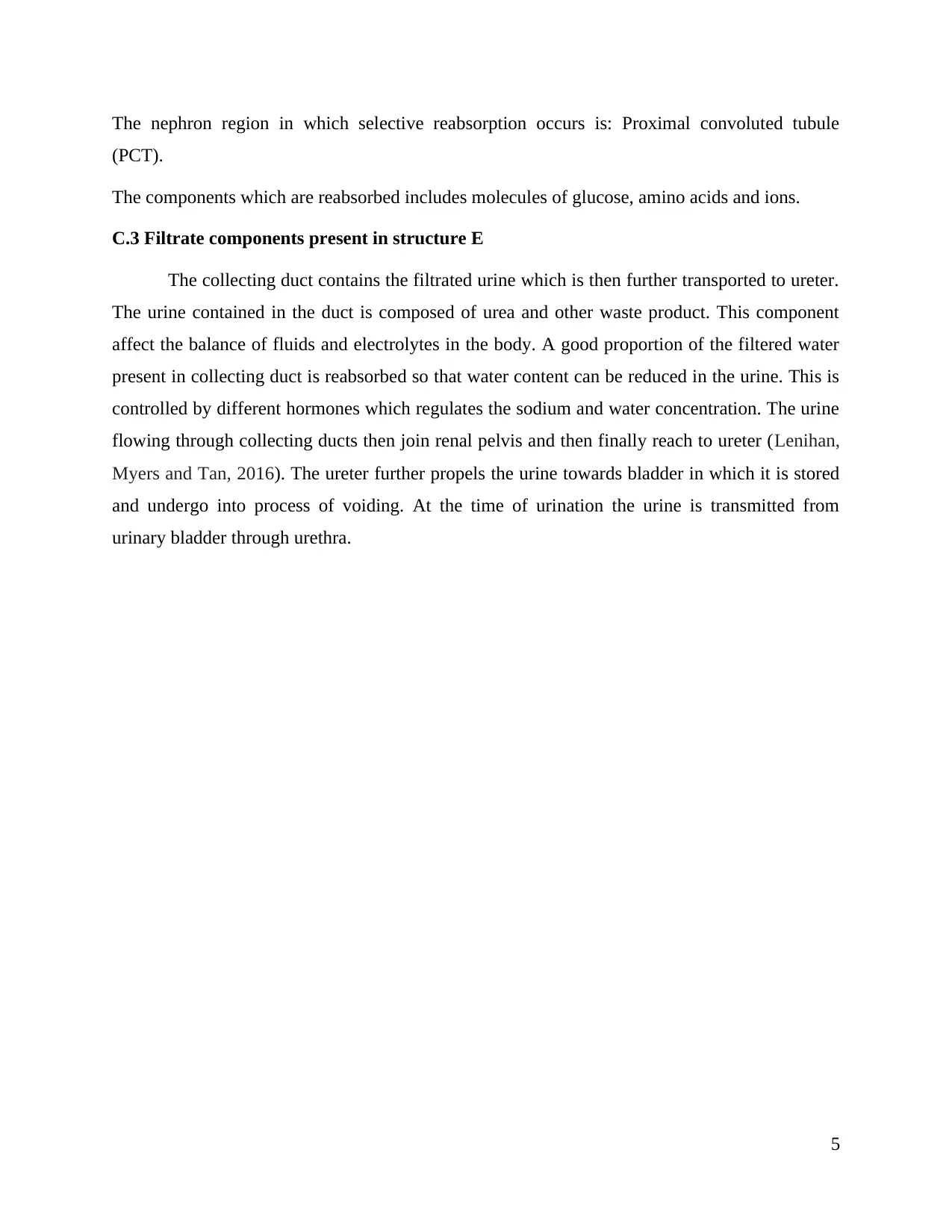
The nephron region in which selective reabsorption occurs is: Proximal convoluted tubule
(PCT).
The components which are reabsorbed includes molecules of glucose, amino acids and ions.
C.3 Filtrate components present in structure E
The collecting duct contains the filtrated urine which is then further transported to ureter.
The urine contained in the duct is composed of urea and other waste product. This component
affect the balance of fluids and electrolytes in the body. A good proportion of the filtered water
present in collecting duct is reabsorbed so that water content can be reduced in the urine. This is
controlled by different hormones which regulates the sodium and water concentration. The urine
flowing through collecting ducts then join renal pelvis and then finally reach to ureter (Lenihan,
Myers and Tan, 2016). The ureter further propels the urine towards bladder in which it is stored
and undergo into process of voiding. At the time of urination the urine is transmitted from
urinary bladder through urethra.
5
(PCT).
The components which are reabsorbed includes molecules of glucose, amino acids and ions.
C.3 Filtrate components present in structure E
The collecting duct contains the filtrated urine which is then further transported to ureter.
The urine contained in the duct is composed of urea and other waste product. This component
affect the balance of fluids and electrolytes in the body. A good proportion of the filtered water
present in collecting duct is reabsorbed so that water content can be reduced in the urine. This is
controlled by different hormones which regulates the sodium and water concentration. The urine
flowing through collecting ducts then join renal pelvis and then finally reach to ureter (Lenihan,
Myers and Tan, 2016). The ureter further propels the urine towards bladder in which it is stored
and undergo into process of voiding. At the time of urination the urine is transmitted from
urinary bladder through urethra.
5
Paraphrase This Document
Need a fresh take? Get an instant paraphrase of this document with our AI Paraphraser
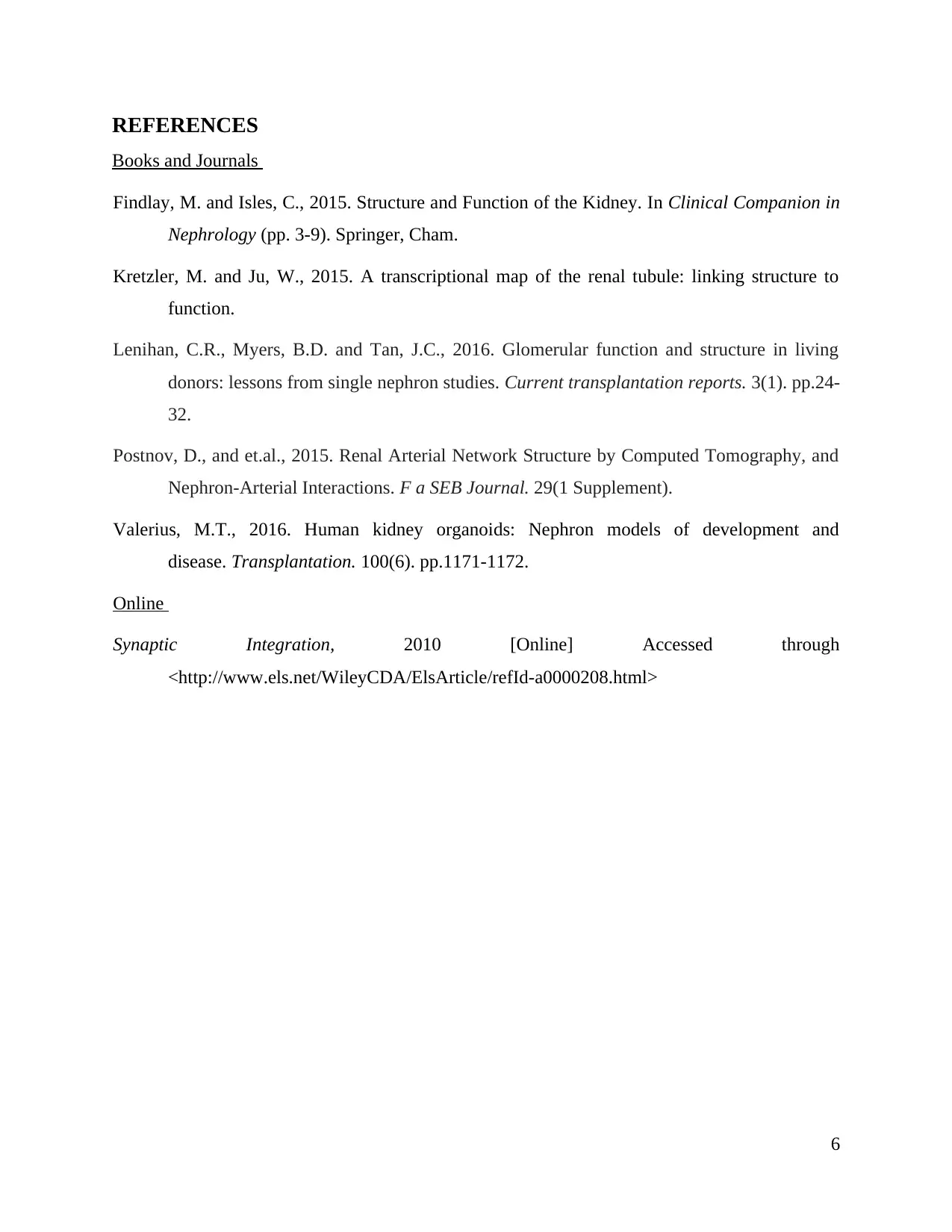
REFERENCES
Books and Journals
Findlay, M. and Isles, C., 2015. Structure and Function of the Kidney. In Clinical Companion in
Nephrology (pp. 3-9). Springer, Cham.
Kretzler, M. and Ju, W., 2015. A transcriptional map of the renal tubule: linking structure to
function.
Lenihan, C.R., Myers, B.D. and Tan, J.C., 2016. Glomerular function and structure in living
donors: lessons from single nephron studies. Current transplantation reports. 3(1). pp.24-
32.
Postnov, D., and et.al., 2015. Renal Arterial Network Structure by Computed Tomography, and
Nephron-Arterial Interactions. F a SEB Journal. 29(1 Supplement).
Valerius, M.T., 2016. Human kidney organoids: Nephron models of development and
disease. Transplantation. 100(6). pp.1171-1172.
Online
Synaptic Integration, 2010 [Online] Accessed through
<http://www.els.net/WileyCDA/ElsArticle/refId-a0000208.html>
6
Books and Journals
Findlay, M. and Isles, C., 2015. Structure and Function of the Kidney. In Clinical Companion in
Nephrology (pp. 3-9). Springer, Cham.
Kretzler, M. and Ju, W., 2015. A transcriptional map of the renal tubule: linking structure to
function.
Lenihan, C.R., Myers, B.D. and Tan, J.C., 2016. Glomerular function and structure in living
donors: lessons from single nephron studies. Current transplantation reports. 3(1). pp.24-
32.
Postnov, D., and et.al., 2015. Renal Arterial Network Structure by Computed Tomography, and
Nephron-Arterial Interactions. F a SEB Journal. 29(1 Supplement).
Valerius, M.T., 2016. Human kidney organoids: Nephron models of development and
disease. Transplantation. 100(6). pp.1171-1172.
Online
Synaptic Integration, 2010 [Online] Accessed through
<http://www.els.net/WileyCDA/ElsArticle/refId-a0000208.html>
6
1 out of 8
Related Documents
Your All-in-One AI-Powered Toolkit for Academic Success.
+13062052269
info@desklib.com
Available 24*7 on WhatsApp / Email
![[object Object]](/_next/static/media/star-bottom.7253800d.svg)
Unlock your academic potential
© 2024 | Zucol Services PVT LTD | All rights reserved.





